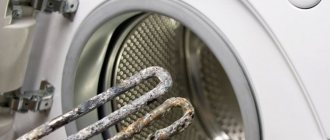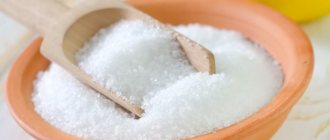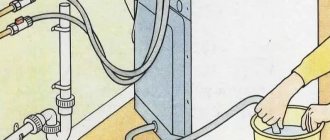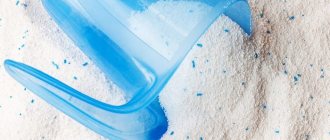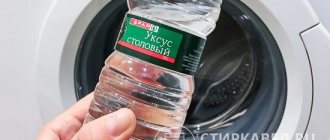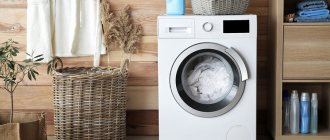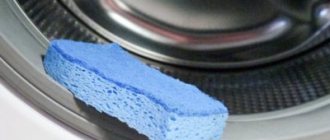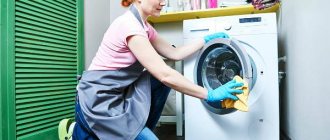Cleaning the body, door and sealing rubber
The rubber seal or cuff of the washing machine is a mandatory element of cleaning during the maintenance process. Rubber should be cleaned carefully, but efficiently, so that there are no leakage problems. Dirt and mold accumulate in this place - which is why it is important to clean regularly. Sediments in this area contribute to the appearance of unpleasant odors.
Any cleaning agent will help in the process, including regular baking soda. In some cases, if mold and a strong smell have already appeared, then it is worth using household chemicals:
- "Domestos".
- "Comet".
- “Whiteness” - it cannot be used often, as this leads to the destruction of the rubber seal. As a result, it will need to be changed.
The order for different means does not differ; it looks like this:
- Apply the product to the sponge.
- Carefully unscrew the cuff of the washing machine towards you.
- Wipe the metal elements of the housing.
- Clean the rubber itself. And not only in the lower part, where dirt accumulates the most, but throughout the entire diameter.
Important! Do not rub very hard so as not to damage the elastic band and other elements of the machine.
You also need to clean the car door. This can be done using a vinegar solution; you will need a 50% concentration of vinegar essence. It’s not difficult to prepare – just take equal parts of essence and water and mix well. All that remains is to wipe the glass and wipe it dry with a dry cloth. Gloves should be used when working with the solution.
The external elements of the washing machine should be wiped with a damp sponge; if necessary, you can use the existing cleaning agent.
Causes of dirt formation
The paradox is that the purpose of the machine is to clean our things, but at the same time the unit itself is extremely sensitive to the dirt accumulating inside. Sometimes even the slightest deviation from sterility leads to breakdown.
IMPORTANT! Most often, the internal elements of the device accumulate dirt, which comes off clothes during washing. Constant dampness and musty air lead to the formation of fungus and mold on the rubber seal and the edges of the drum.
One of the most important elements in a washing machine, the heating element (heating element), also suffers from contamination. All the scale and deposits remaining from salts collect on it (especially if the water is hard).
Sources of washing machine contamination:
- increased water mineralization;
- the use of aggressive household chemicals, as well as low-quality laundry preparations;
- improper use or care of the device;
- Frequent washing of excessively soiled items (for example, clothes with residues of mortar, machine oil, paint, etc.).
Cleaning the powder tray
Before cleaning this component of the washing machine, it must be removed. If you don’t remember how to do this, it’s better to look in the instructions for the device so as not to break anything in the process. If you can’t remove the tray (this happens), you can still clean it, but you will need to pre-soak it. There are many places in the tray that are difficult to reach. To soak, you need to make a solution of any detergent and spray the tray with a spray bottle, leave for 2-3 hours. After this, cleaning will be much easier.
If you managed to remove the tray, then everything is even easier. If residues of powder or other product are found inside, it should be removed. This element needs cleaning, as over time a coating of rust, powder and other products forms on it. The following will help in removing all this plaque:
- Soda-vinegar mixture - proportions 1:2.
- Hot water + baking soda + vinegar - you need 3 parts water, 1 part baking soda and 2 parts vinegar.
Having prepared the product, it should be applied to all elements of the tray and left for 2-3 hours. Only then start cleaning with a sponge (large elements) and a toothbrush (hard-to-reach places). All that remains is to rinse the tray under running water and let it dry or wipe it dry.
Advice! If you have a dishwasher, you can wash the tray in it. It will not help get rid of plaque completely, but after such preliminary cleaning it will be easier to remove dirt.
Cleaning the filter
The drain pump filter is an important part of the machine; if you do not pay proper attention to it, sooner or later a blockage will form and the washing machine will not drain water at all. There is no need to invent any complicated cleaning methods, everything is extremely simple. To do this, you will need a small container, a towel or rag, or any flat object that will help open the hatch.
The order is:
- Open the hatch to gain access to the filter drain hose.
- Before unscrewing the filter, lay down a rag (towel) and place a container - a small volume of water will flow out of the hole. Maximum - 0.5 l, very rarely more.
- After removing the lid (unscrewing it completely), you need to remove accumulated debris, dirt, sometimes there are coins, wool and other foreign objects.
- Wipe the hole, rinse the lid, reassemble in reverse order.
The washing machine also has a water inlet filter, which should also be cleaned. Over time, clogging with rust and sand occurs. If these deposits are critical, then an error appears on the machine screen, which can be interpreted as “water collection is impossible.”
Important! The hose located directly on the water supply should be cleaned no more than 2-3 times a year.
The process looks like this:
- Close the water supply tap to the device.
- Open access to the back cover; often the device needs to be unfolded.
- The water supply hose is located at the top right.
- You should unscrew the nut that secures it counterclockwise.
- You can see a mesh filter inside. It should be removed and washed with a toothbrush under running water.
- All that remains is to put the filter in place and screw on the hose.
How to remove scale with citric acid
The biggest enemy of the internal parts of the machine is scale. You can fight it with the help of special chemicals, or you can use citric acid.
The main object is the heating element or heating element. For him, scale has a detrimental effect. Citric acid will also effectively remove scale from all metal elements of the washing machine. The procedure is simple, you don’t even have to use a rag or sponge, it consists of the following steps:
- Free the device from all things.
- Pre-rinse the cuff and door glass.
- Pour citric acid into the powder compartment. For cars with a volume of 5 kg - 100 g, 6 kg - 120 g.
- Turn on the washing machine at +90⁰ and the longest program.
- Once the cycle is completed, the cleaning is also completed.
The main protection of heating elements is timely descaling.
Important! There are special products for removing scale, for example the domestic “Antinakipin” and “Doctor TEN”. To soften water and prevent scale formation, use Calgon or its cheaper analog Refine.
Citric acid not only removes scale, but also helps get rid of unpleasant odors and mold.
You can also descale your washing machine with vinegar. This method is extremely simple, very similar to the option with citric acid. The work will require 9% vinegar, which must be poured into the powder compartment in an amount of 100 ml. The machine should be started at the longest and highest temperature setting. When the water heats up, stop the cycle for 1.5 hours, then allow the process to complete.
Product Impact Benefits
Lemon acid
Upon contact with the drum and other parts of the machine, it removes scale, grease residue, soap scum and mold. Low cost. Does not require physical effort, since it is used in automatic mode. Does not harm unit parts.
Chlorine bleach (white)
Baking soda Vinegar concentrate (acid) Cleans the drum and other machine parts from dirt and scale. Low cost.
Removes scale and other types of dirt. Low cost. High level of efficiency. Automatic cleaning mode. Cleans the walls of the drum from dirt, but does not affect the heating element (heating element) and the tank. Low cost. Harmless to device parts. Efficient in drum cleaning. High level of efficiency. The cleaning mode is automatic.
[custom_ads_shortcode2]
Cleaning the drum with baking soda
The drum is easy to clean; to do this, you need to prepare a paste of water and soda. Apply it to the drum using a sponge and rub. After cleaning, rinse with water and wipe dry. Soda perfectly helps to cope with mold and fungi, which happily settle in such comfortable conditions. To prevent the formation of mold with this simple remedy, you should clean your washing machine at least once a week.
Advice! In a similar way, you can clean the drum inside the device with Domestos.
Prevention
In order for the washing machine to operate without failures, it is necessary to periodically prevent the formation of plaque.
You can prevent the appearance of scale by following several rules:
- Always add detergent (powder or gel) only to the appropriate compartment and not to the drum.
- Reduce the frequency of using modes in which water is heated above 40 °C to a minimum.
- Periodically (about twice every six months) activate the washing program with an empty drum and adding acid-containing products.
- When using gels and other thick detergent compositions, include an additional rinse to completely flush out any remaining residue from the tank.
You can also add 2 tablespoons of soda ash or another water softening compound with each wash. If you wash items made from delicate fabrics, you should not use baking soda.
The most effective way to prevent plaque is to install cleaning and softening filters.
How to clean mold from a washing machine
As already mentioned, you can use baking soda and citric acid to clean mold from your washing machine. Will also help:
- Whiteness . You will need to pour 1 liter of product into the compartment and turn it on at the highest temperature of at least 60⁰. When the temperature is at its maximum, stop the cycle for 2 hours. After this time, allow the cycle to complete. The use of this cleaning material should not be too frequent, as it has an aggressive effect on some parts of the machine.
- Soda Ash. The cleaning process is the same as usual, but it is worth remembering that this substance is aggressive, so you need to use personal protective equipment during the process. For prevention, it is recommended to add soda ash at each washing cycle.
What not to do
When rust appears on a washing machine, it is necessary to analyze the conditions of its maintenance. If the room is too humid, the surfaces and parts of the machine will inevitably rust, and the top panel of the unit will rust first. Therefore, it is not recommended to use the washing machine indoors in open water tanks and at high air humidity.
Rusty stains that appear on the machine indicate poor quality of water used for washing. Its composition needs to be improved; it may be necessary to install cleaning filters and water softeners. Important: under no circumstances should you rub rusted areas with washing powder.
The surface will be covered with scratches, which will later harbor bacteria and harmful microbes. Do not leave the machine with laundry in the drum and water after washing.
Many users mistakenly assume that the best installation location for a washing machine is the bathroom. This is not entirely true, the bathroom is a room with high humidity, this is steam, splashes that can fall on the machine, condensation, etc.
You need excellent ventilation, a working heated towel rail, a forced ventilation fan, ventilation holes at the bottom of the door leaf (in the bathroom, most doors have a threshold and there is no ventilation gap between the floor and the door leaf). That is, the bathroom needs to be prepared for installing the washing machine + the correct distance from the source of moisture must be maintained, for example a sink faucet with a high spout (gander), moisture can constantly get on the body of the washing machine.
None The cause of rust inside is left with damp clothes in the washing machine.
Do not open the washer hatch for ventilation. Rust in the area of the cuvette (powder tray), the tray must also be wiped and removed after each wash.
What to do depends on the situation; in some cases, if there is rust from the inside, nothing can be done; the rusted components need to be replaced. First, eliminate the cause of the humidity in the room, clean the ventilation, etc.
If there is rust on the outside, then disconnect the washing machine from the communications. You can remove the rusty panel, you can try to remove the rust locally by covering with masking tape those areas that will not be restored.
First, we clean the problem area with fine-grain sandpaper (down to “living” metal), and remove the dust after cleaning. Next we degrease the surface.
The next stage is a primer, for example, zinc aerosol primer is not a bad option (this primer stops the corrosion process), or immediately buy primer-paint, or “rust-proof” paint (3 in one). Shake the can of primer and apply it evenly.
After the primer has dried, the surface is painted. I bought this one.
repair white enamel (aerosol) for Kudo household appliances (most often white washing machines). This, like a primer, is an aerosol enamel.
Shake the can and apply the first layer of paint, dry, then the second layer of enamel.
A washing machine, like any other unit, requires care and cleaning. It is much easier to regularly carry out preventative measures and general cleaning than to pay for expensive repairs. Our company carries out installation, repair and cleaning of washing machines in Krasnodar. Professionalism, speed and quality of service will delight our clients, as will the affordable price range for all kinds of services.
How to clean an automatic washing machine
, a qualified service technician can explain. It is not recommended to carry out these procedures on your own.
[custom_ads_shortcode1]
Cleaning rust
Cleaning rust from machine parts can be done with citric acid or vinegar, but only if the extent of the “damage” is insignificant. Apply the substance to the rusty areas, leave for 1-2 hours, then scrub with steel wool.
Baking soda will also help in the fight against rust; apply a mixture of soda to the rust, rub it with a washcloth after 15-20 minutes and rinse with water.
There are also special rust removers, use them according to the instructions.
If the drum and external surfaces of the machine machine parts are heavily rusted, they must be replaced.
Important! After each wash, leave the door open for a couple of hours. This will help excess moisture evaporate, and the parts of the unit will not wear out so quickly.
What tools can be used
When removing rust from a washing machine, you can use both specialized products, purchased at household chemical stores, and improvised products available in any home. The cleaning principle is almost the same, regardless of whether soda, vinegar or citric acid is used. Having treated the damaged area, work is suspended for a few minutes, and then the rust is removed and the surface is wiped with a damp cloth.
A mixture of lemon juice and vinegar is applied to the rusted areas of the unit and after two hours it is necessary to clean the treated areas with a wire brush. Remaining rusty dust is removed with a clean damp cloth.
[custom_ads_shortcode3]
How to clean animal hair
The people who suffer most from pet hair near the washing machine are:
- Water level sensor, also known as pressure switch. After each cycle, it is systematically clogged with wool. To clean, disconnect the sensor tube and clean it under running water.
- Pump filter. Its cleaning is described above. You need to remember that if there are pets in the house, then it is advisable to clean this element after each washing cycle.
To avoid problems with hair deposits, items are cleaned of animal hair before putting them in the washing machine. Of course, you won’t be able to remove everything, but this procedure will still make the fate of the household appliance easier.
Useful tips
- During the washing process, use exactly the amount of powder, conditioner, and bleach that is needed. Excess will settle in the appliance, which can cause dirt and odors.
- Before washing, remove excess from all pockets.
- If dirty things are in the drum, then there is no need to delay the start. The same goes for removing washed laundry.
- For washing, use low and medium temperature modes more often - this also prevents the appearance of scale.
- If the water is hard, then an excellent method of prevention would be to use a magnetic filter in front of the water supply hose.
- After washing, leave the machine door open.

